I thought all cows ate grass…
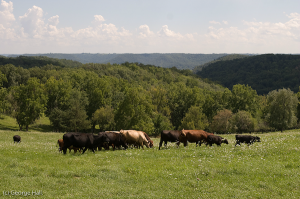
If asked, most people could not tell you where the meat on their plate came from. In fact, if they wanted to know, it would be darned difficult – if not impossible – to find out. On the other hand, while imagining that the beef cow they will be eating is frolicking on lush green pastures, the average American today does NOT want to meet their dinner while it is still standing.
No, Virginia, not all cows eat grass. That lovely image of a herd of cattle happily munching away and contentedly chewing their cud is mostly a figment of your imagination.
Over the last 70 years, the beef industry has evolved into an intense, industrial enterprise designed to put as much weight on animals as fast as possible and get the resulting meat to market as quickly as possible.
To do that, beef cattle – who are by nature ruminants (grass eaters) – are hustled off the pasture where they spent their first six months of life to spend the next six to eight months packed into confined animal feeding operations (CAFOs) with no green pasture in sight. In those feedlots, they are fed grain – lost of grain – to bring them up to the target weight for slaughter. Since it takes as much as 7 pounds of grain (corn, barley, soybeans, and other grain) to develop a pound of meat and those cattle gain about 3 pounds a day, that’s a lot of feed.
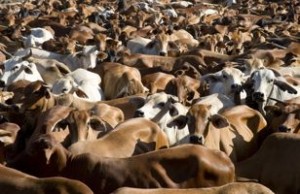
At the same time, to keep the cattle gaining weight, they are given growth hormones and antibiotics. According to the Union of Concerned Scientists, 70% of all antibiotics used in the United States are fed to livestock. And, as many as six different growth hormones may be given to beef cattle, three of which occur naturally and three of which are synthetic.(1)
Since those animals are eating 50 to 60 pounds of feed a day, a quick look at the source of that feed is important. Forty-four percent of the corn grown in the US is used for animal feed, and 86% of the corn planted in 2010 was bio-engineered varieties that contained insect- or herbicide-resistant genes (or both). Fifty-nine percent of the soybean harvest is crushed for oil, however the meal left over from the crush is used as animal feed. A whopping 94% of all soybeans grown are genetically engineered to be herbicide tolerant.
Meat and potatoes, please…
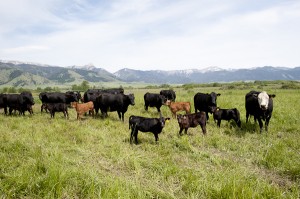
Researchers have linked serious health problems such as heart disease, stroke, diabetes, and certain types of cancer to heavy meat consumption. Americans eat more meat than ever before, and most of it is high in saturated fats.
We consume about 67 pounds of beef a year for each person – man, woman, and child. And those animals eat a lot of corn and other grain: most beef cattle are “finished” on grain before slaughter; only a very small percentage is entirely “grass-fed.”(2)
Ah, back to that question – don’t cows eat grass? More and more farmers and ranchers are raising grass-fed beef on a natural diet consisting of fresh grasses, legumes, and other plants and allowing them to roam about.
Many are choosing to follow organic practices in their herd management, which are clearly healthier and more humane for the animals. The good news is that meat from those animals is free of antibiotics, steroids, hormones, pesticides, herbicides and other potentially toxic substances. The bad news is that it can take nearly two years to bring those animals to market on grass.
Studies have shown that an animal’s diet can have an impact on the nutritional content of the meat on the consumer’s table. Grass-fed meat has been shown to contain less fat, more beneficial fatty acids, and more vitamins and to be a good source of a variety of nutrients. According to a study published in the Journal of Animal Science in 2009, eating grass-fed beef provides many benefits to consumers(3):
- Lower in total fat
- Higher in beta-carotene
- Higher in vitamin E (alpha-tocopherol)
- Higher in the B-vitamins thiamin and riboflavin
- Higher in the minerals calcium, magnesium, and potassium
- Higher in total omega-3s
- A healthier ratio of omega-6 to omega-3 fatty acids (1.65 vs 4.84)
- Higher in CLA (cis-9 trans-11), a potential cancer fighter
- Higher in vaccenic acid (which can be transformed into CLA)
- Lower in the saturated fats linked with heart disease
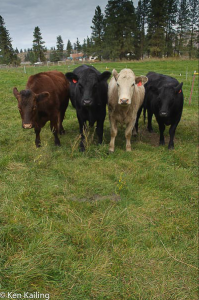
Lower Fat – Meat from grass-fed cattle is much lower in fat, and therefore lower in calories. A 6-ounce steak from a grass-finished animal has almost 100 fewer calories than the same sized-piece from a grain-fed animal. If, like the average American, you eat about 67 pounds of beef a year, switch to grass-fed beef and you’ll save nearly 18,000 calories a year.
Omega-3 Fatty Acids – Omega-3 fatty acids are fats that are essential to human health. Sixty percent of the fatty acids in grass is omega-3, which is formed in the chloroplasts of green leaves. Grass-fed cattle can contain as much as two-to-four times more omega-3 fatty acids than grain-fed animals.
At the same time, a high ratio of omega-6 to omega-3 fatty acids has been linked with an increased risk of cancer, cardiovascular disease, allergies, depression, obesity, and autoimmune disorders. A ratio of four to one or lower is considered ideal, Grain-fed beef has a much higher ratio of omega-6 to omega-3 fatty acids than wild game or grass-fed beef. In grass-fed beef the ratio is approximately 2 to 1, while the ratio in grain-fed beef is more than 14 to 1.
More Vitamins – In humans vitamin E is linked with la lower risk of heart disease and cancer. Meat from grass-fed cattle is higher in vitamin E.; as much as four times higher in vitamin E than meat from feedlot cattle.(4)
Rich source of CLA – Meat from grass-fed animals is the richest known source of “conjugated linoleic acid” or CLA. Grass-fed cattle have been found to produce 2 to 5 times more CLA than cattle fed high grain feedlot diets. In laboratory animals, a diet containing even a small amount of CLA greatly reduced cancerous growths.
More to Come
Over the next couple of weeks we will be looking at meat – particularly beef – as part of our diets, our culture, our economy, and our environment. Where does your meat come from? Do you really know?
________________________________________
Resources:
(1) Union of Concerned Scientists, http://www.ucsusa.org/food_and_agriculture/solutions/wise_antibiotics/pamta.html
(2) Farm Animal Statistics, http://www.humanesociety.org/news/resources/research/stats_meat_consumption.html
(3) S.K. Duckett et al, Journal of Animal Science, (published online) June 2009, “Effects of winter stocker growth rate and finishing system on: III. Tissue proximate, fatty acid, vitamin and cholesterol content.”
(4) Dietary supplementation of vitamin E to cattle to improve shelf life and case life of beef for domestic and international markets. G.C. Smith, Colorado State University, http://www.animalfeedscience.com/article/0377-8401%2895%2900901-9/abstract
A special tip of the hat to Eric Beswick for fact-checking!

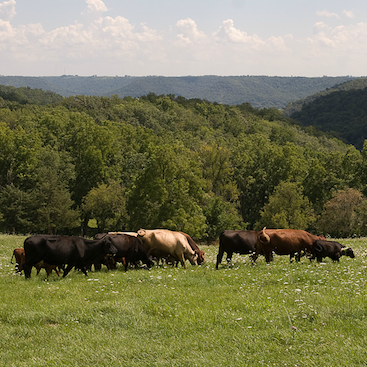
they would rather have grain than grass Mike
Thank you, Anne Burkeholder, for your obviously sincere effort to raise the bar on feedlot finished beef. Our family is one of those that has sworn off fast food beef for many reasons, and have been purchasing only grass finished organic from very small producers for the past several years. We would like to start a beef raising program of our own and are wading through this mess of industrialization vs buy local grass fed, etc., etc. It seems as though the issue is the same as we find in every industry, greed. Your family’s story and style of operation is critical if feedlot beef is to be a sustainable operation. We feel that grass fed is better, even if a longer, albeit more natural process. I also realize that this isn’t heaven, and we must do the best we can with what resources we have. The problem lies in the lack of moderation in how we produce. If money becomes the only focus then we have immediately lost. There must be a place for naturally raised non gmo non antibiotic beef. It seems there also must be a place for feedlot beef, but only if raised with the care and kindness your operation seems to exemplify. I do not believe, however, that your operation is the norm in the industrial beef growing circles. I worked on a large cattle ranch , (which was wonderfully managed, by the way) for some time and subsequently was exposed to some of the southwestern area feedlots. Suffice it to say that I am convinced we need to see more local focused grass finished beef growing operations in rural America and such operations should coexist with operations like yours. Animal Husbandry is becoming a back seat passenger to greater industrialization and profit making.
To you and your family, all the best in your endeavors and may your purpose always be an eternally rewarding one.
JB
As a cattle producer, if I do not practice good animal husbandry I would not survive within the feedlot industry. Healthy cattle grow more quickly & produce higher quality beef, both of which are critical to the profitability & sustainability of a cattle producer. Cattle get sick, just as humans do, regardless of whether they are in the pasture or in a feedyard. If they get sick, it is only in the best interest of the animal that they be treated with the appropriate medical care. If your son or daughter gets sick do you make them “tough it out” or do you give them the medical care necessary to help them get better? Additionally, the diets that cattle eat within a feedyard are likely more nutritious & well balanced than what we humans eat. Additionally, in order to produce beef I must also comply with all of the regulations established by the US Department of Agriculture. These regulations are in place in order to insure that we have the safest food supply in the world. I produce both natural & commodity beef for the food industry and can confidently say that both provide a healthy & nutritious product for consumers. One difference between the two is that raising natural cattle requires a great deal more feed (whether it’s grass or grain) in order to reach the appropriate market weight. If all cattle were raised “naturally” we would need over 5 times the land base to produce the same amount of beef we do today. That said, we in the beef industry offer consumers many different options (grain fed/grass fed/hormone free etc)when it comes to the type of beef they may choose to eat. One just needs to note that they are all produced under the rules & regulations of the USDA, making them all safe. In summary, regardless of which setting our food is produced within America, we have the safest, most highly regulated food supply in the world of which we can all be very confident in consuming. Those who may argue these points should take more time to inform themselves as to the facts. We must all use common sense when considering all of the information provided to us when it comes to food safety. Heaven forbid if any of you complain about food safety & then head outside for a cigarette!
Christopher,
I very much appreciate your comments. That said, at GoodFood World we believe that humans should eat less meat – even grass-fed and organically raised meat – and for the very reasons that you mention.
By raising grains – with much effort, chemical inputs, and water – to feed to livestock, we are getting a rather inefficient conversion from seed to meat. If we consumed a diet higher in plant-based protein (notice I’m *not* saying don’t eat *any* meat), we can reduce the amount of resources used.
As to your final point – I’m a real stickler for food safety and proper handling of food at all stages of production and processing – and BTW, I don’t smoke (never have)…
Please keep the conversation going, we’ll never get anywhere if we shut the door.
Gail N-K
If you haven’t read the Pew Commission on Industrial Farm Animal Production report “Putting Meat on the Table: Industrial Farm Animal Production in America,” (2008), get a copy: http://www.ncifap.org/_images/PCIFAPFin.pdf. Eye-opening reading…
Gail N-K
Co-Publisher, GoodFood World
I personally have little to add to this other then to say there are no good reasons for keeping animals raised for food in tightly confined feed yards, lots or warehouses. The conditions always result in sick animals requiring drug treatment, ecologically harmful manure management situations (a full grown cow, for instance, can produce 40lbs of manure a day), and the probability of spreading disease.
The goal of such operations is simple: fatten the animals up as quick as possible in an effort to turn a maximum profit. It can even be argued (though hard to find anything on the web that strives to prove it that hasn’t been funded by some feedlot cattle association, council or some such) that the propagation of E. coli O157:H7 would probably not even be a factor if it weren’t for feedlot conditions. Stressed, confined animals and the overuse of antibiotics as routine is just a small part of the unhealthy industrialized meat production model. http://www.ericsecho.org/whatisec.htm & http://www.saveantibiotics.org/basics.html for more information.
Hi Gail and other readers,
I am the manager of a cattle feed yard in Central Nebraska, and I would like to invite you to take a look at my blog site where I talk about how I care for cattle and raise beef in a cattle feed yard. I have many many pictures up on the site along with several videos (one on the home page and one recent one in a post called “Movie Night With Feed Yard Foodie”) so that my readers can see first hand what life in a cattle feed yard is like. The site is http://feedyardfoodie.com.
I very much believe that my animals are well cared for and comfortable while living in my feed yard. You will see from my pictures that they have lots of room to run and play in the pen and are not at all crammed in as the picture that you placed in your post depicts. I also have several blog posts regarding both antibiotic and hormone use to better explain how both are used in my feed yard. Animal care is very important to me—my life centers around my animals and their needs and I believe that I grow a safe and nutritious beef product that I feed to my family and families all around the world. I use antibiotics judiciously and under the strict supervision of my veterinarian, and I realize how important that is to both my animals and to the people that eat the beef that my animals produce.
I also have many posts that talk about what I feed to my cattle while they are in my feed yard, as well as many pictures of those feed ingredients. My cattle are fed a blend of wet distillers grain (this is what is left over after the ethanol is extracted from the corn plant); and grass, alfalfa, corn stalks and wheat stubble (these are the fiber/ forage part of both plants–not the grain part). This blend of grain and grass/forage is created under the supervision of a Ruminant Nutritionist (a PhD cattle nutritionist) to ensure that our animals have healthy digestive tracts. All of the feed that is fed to my animals comes from local sources (we grow some of our own and then purchase the rest of what we need from other local sources).
I hope that you will take a look at my blog site so that you can see how I raise cattle in a feed yard. I think that you will find that it is very different from what you describe above. It is so important for the consumer to be able to connect with their food source and I work very hard to both offer good care to my animals and also to share the story of that care with the people that eat my beef. Thank you
for opening the door so that this conversation could occur.
All the best,
Anne Burkholder (Feed Yard Foodie).
Anne, I’m sorry to say, but your cattle cannot possibly have healthy digestive tracts if you’re feeding them grains. These are ruminant animals and are therefore not evolved to properly digest grains–plain and simple. I’m sure you mean well, but your “Ruminant Nutritionist” is full of it when s/he tells you that it’s ok to feed this stuff to your cattle. This is similar to a Registered Dietician recommending that people eat lots of “healthy whole grains.” Our own human bodies likewise cannot properly metabolize a lot of grains, especially all the gluten-heavy grains like wheat, the darling of the dietetics field.
Just because some Registered Dieticians recommend such a diet for humans does not actually make it useful advice. These “nutrition experts,” after all, are part of an organization that regularly accepts large sponsorship contracts from major junk food companies like Coca Cola and McDonald’s. I wouldn’t be surprised to hear about ruminant nutritionists having similarly questionable ties to the food industry.
(Note: this was re-posted to correct for a spelling error. :))